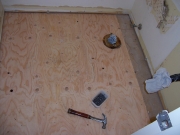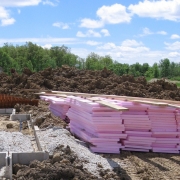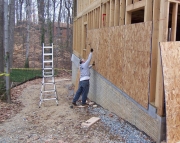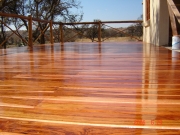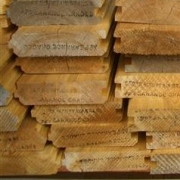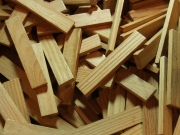- Error
{Re}habitat
Learn how adaptive reuse and upcycling can add hip design to your home, apartment, or yard with the Go Green channel's {Re}habitat series. Follow host Rachael Ranney as she shows you how to repurpose salvaged and found materials, adding fun and function to your space without breaking your budget.

Wood based underlayments are panel or sheet materials that are used between a structural subfloor and a finish floor surface. Also known as overlayment, wood panel materials are commonly used under resilient tile or sheet floors. They can also be used under adhered carpet or other nonstructural flooring as well.
Subflooring is the structural component of a building that provides rigidity to the floor structure, supports live loads, and serves as the surface to which floor finishes can be applied. Wood subflooring is installed in all types of structures, including timber, platform, and balloon framed. It can also be used in special applications such as radiant heat, floating, raised, or sprung floors. Common types of wood subfloor include individual wood boards and wood panels.
Commonly wrapped around the outside of a structure, insulating sheathing is popular today because of demanding energy codes. Insulating sheathing is a foam insulated board material that reduces energy consumption. It does not have any structural ability and it requires additional lateral bracing to resist seismic and wind loads. Common types of insulating sheathing include polyisocyanurate, molded expanded polystyrene and extruded expanded polystyrene.
Sheathing is the board or panel material used in floor, wall and roof assemblies of both residential and commercial construction. The most basic function of sheathing, in any application, is to form a surface onto which other materials can be applied. There are several types of sheathing, each having a specific function based on its application.
Wood patio decks are outdoor living spaces that are built above ground. While they typically adjoin a structure, such as a home, they can also be built as a boardwalk or be atop a building as an observation deck. The structure of a wood patio deck is commonly framed with treated lumber. While a number of different types of wood, including softwood, hardwood, domestic or tropical wood, can be used for the top surface deck, each has it's own advantages and disadvantages.
Wood decking is created using structural boards or planks and attaching them to joists, beams, rafters, or trusses to form a floor or roof surface. Similar to sheathing, the boards act to provide lateral support to the structure and carry the live and dead loads from above to the floor or roof structure below.
Treated wood foundations are load-bearing, pressure-treated wood framed walls, used below grade to support light frame construction. Treated wood foundations are commonly called Permanent Wood Foundations or All-Weather Wood Foundations. Since being developed in the 1960s, this unique building system has had its skeptics; however, it has proven to be a durable building system in thousands of physical applications. Treated wood foundations have undergone extensive research, analysis, and testing by several highly respected organizations within the building construction industry. They have been approved for use by model building codes, many state and local building codes, federal agencies, and by lending, warranty and insurance institutions. A treated wood foundation, when installed, waterproofed, and drained properly, and used in conjunction with other waterproof materials, is a viable alternative to poured concrete or concrete block foundations.
Pole framing or post-frame construction is a simple, cost effective durable design that was developed during the 1930s. Originally constructed with round utility poles, today's pole buildings utilize laminated columns or square posts. The poles or posts are joined to create a building frame that siding is attached to and rafters are rested upon and secured to. Pole construction has commonly been used to build garages, agricultural and equestrian structures, and airplane hangers, but can also be used in the construction of low rise commercial or residential structures.
